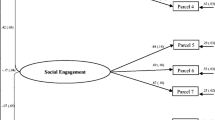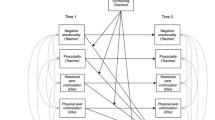Abstract
The aim of this study was to investigate the toddler and preschool predictors of early peer social preference. Behavioral and social functioning were examined in a sample of children across the toddler and preschool years from parent and teacher observations. Kindergarten social behavior and peer social preference were assessed in the children's kindergarten classrooms using standard sociometric techniques. Results indicated that parent report of toddler externalizing behavior and teacher report of preschool problem behavior, as indexed by aggressive behavior, social skills, and emotional regulation, were predictive of peer liking in kindergarten. However, this relation was mediated by specific behaviors evidenced in the kindergarten classroom. For boys, overt aggression mediated these relations. For girls, sharing and engaging in sneaky behavior in kindergarten mediated the relation between preschool problem behaviors and peer status. These results indicate that specific behaviors displayed in the peer group account for the relation between early problem behavior and peer status. Moreover, these data point to the importance of considering gender when examining developmental trajectories and outcomes.
Similar content being viewed by others
REFERENCES
Achenbach, T. M. (1992). Manual for the Child Behavior Checklist/2-3 & 1992 Profile. Burlington: University of Vermont, Department of Psychiatry.
Achenbach, T. M., Edelbrock, C., & Howell, C. T. (1987). Empirically based assessment of the behavioral/emotional problems of 2-and 3-year-old children. Journal of Abnormal Child Psychology, 15, 629-650.
Baron, R. M., & Kenny, D. A. (1986). The moderator-mediator variable distinction in social psychological research: Conceptual, strategic, and statistical considerations. Journal of Personality and Social Psychology, 51, 1173-1182.
Belsky, J., Hsieh, K. H., & Crnic, K. (1998). Infant positive and negative emotionality: One dimension or two? In M. E. Hertzig & E. A. Farber (Eds.), Annual progress in child psychiatry and child development (pp. 29-44). Philadelphia: Brunner/Mazel.
Belsky, J., Woodworth, S., & Crnic, K. (1996). Troubled family interaction during toddlerhood. Development and Psychopathology, 8, 477-495.
Broidy, L. M., Nagin, D. S., Tremblay, R. E., Bates, J. E., Brame, B., Dodge, K. A., et al. (2003). Developmental trajectories of childhood disruptive behaviors and adolescent delinquency: A six-site, cross-national study. Developmental Psychology, 39, 222-245.
Calkins, S. D., & Dedmon, S. E. (2000). Physiological and behavioral regulation in two-year-old children with aggressive/destructive behavior problems. Journal of Abnormal Child Psychology, 28, 103-118.
Calkins, S. D., Gill, K., & Williford, A. (1999). Externalizing problems in two-year-olds: Implications for patterns of social behavior and peers' responses to aggression. Early Education and Development, 10, 267-288.
Campbell, S. B. (1991). Longitudinal studies of active and aggressive preschoolers: Individual differences in early behavior and outcomes. In D. Cicchetti & S. L. Toth (Eds.), Internalizing and externalizing expressions of dysfunction. Rochester Symposium on Developmental Psychopathology (Vol. 2, pp. 57-89). Hillsdale, NJ: Erlbaum.
Campbell, S. B. (1994). Hard-to-manage preschool boys: Externalizing behavior, social competence, and family context at two-year follow-up. Journal of Abnormal Child Psychology, 22, 147-166.
Campbell, S. B. (2002). Behavior problems in preschool children: Clinical and developmental issues (2nd ed.). New York: GuilfordPress.
Campbell, S. B., Pierce, E. W., Moore, G., Marakovitz, S., & Newby, K. (1996). Boys' externalizing problems at elementary school age: Pathways from early behavior problems, maternal control, and family stress. Development and Psychopathology, 8, 701-719.
Campbell, S. B., Shaw, D. S., & Gilliom, M. (2000). Early externalizing behavior problems: Toddlers and preschoolers at risk for later maladjustment. Development and Psychopathology, 12, 467-488.
Cohen, S., & Bromet, E. (1992). Maternal predictors of behavioral disturbance in preschool children: A research note. Journal of Child Psychology and Psychiatry, 33, 941-946.
Coie, J. D., Dodge, K. A., & Coppotelli, H. (1982). Dimensions and types of social status: A cross-age perspective. Developmental Psychology, 18, 557-570.
Coie, J. D., Dodge, K. A., & Kupersmidt, J. B. (1990). Peer group behavior and social status. In S. R. Asher & J. D. Coie (Eds.), Peer rejection in childhood. Cambridge studies in social and emotional development (pp. 17-59). New York: Cambridge University Press.
Coie, J. D., & Krehbiel, G. (1984). Effects of academic tutoring on the social status of low-achieving, socially rejected children. Child Development, 55, 1465-1478.
Coie, J. D., Lochman, J. E., Terry, R., & Hyman, C. (1992). Predicting early adolescent disorder from childhood aggression and peer rejection. Journal of Consulting and Clinical Psychology, 60, 783-792.
Coplan, R. J., & Rubin, K. H. (1998). Exploring and assessing nonsocial play in the preschool: The development and validation of the Preschool Play Behavior Scale. Social Development, 7, 72-91.
Coplan, R. J., Rubin, K. H., Fox, N. A., Calkins, S. D., & Stewart, S. (1994). Being alone, playing alone and acting alone: Distinguishing among reticence, and passive-and active-solitude in young children. Child Development, 65, 129-137.
Crick, N. R., Casas, J. F., & Mosher, M. (1997). Relational and overt aggression in preschool. Developmental Psychology, 33, 579-588.
Crick, N. R., & Grotpeter, J. K. (1995). Relational aggression, gender, and social psychological adjustment. Child Development, 66, 710-722.
Crick, N. R., & Rose, A. J. (2000). Toward a gender-balanced approach to the study of social-emotional development: A look at relational aggression. In P. H. Miller & K. S. Ellin (Eds.), Toward a feminist developmental psychology (pp. 153-168). Florence, KY: Taylor & Francis/Routledge.
Denham, S. A., McKinley, M., Couchoud, E. A., & Holt, R. (1990). Emotional and behavioral predictors of preschool peer ratings. Child Development, 61, 1145-1152.
Doyle, A., Ostrander, R., Skare, S., Crosby, R. D., & August, G. J. (1997). Convergent and criterion-related validity of the Behavior Assessment System for Children-Parent Rating Scale. Journal of Clinical Child Psychology, 26, 276-284.
Egeland, B., Kalkoske, M., Gottesman, N., & Erickson, M. F. (1990). Preschool behavior problems: Stability and factors accounting for change. Journal of Child Psychology and Psychiatry and Allied Disciplines, 31, 891-909.
Frentz, C., Gresham, F. M., & Elliot, S. N. (1991). Popular, controversial, neglected, and rejected adolescents: Contrasts of social competence and achievement differences. Journal of School Psychology, 29, 109-120.
Greenberg, M. T., Speltz, M. L., DeKlyen, M., & Endriga, M. C. (1991). Attachment security in preschoolers with and without externalizing behavior problems: A replication. Development and Psychopathology, 3, 413-430.
Gresham, F. M., & Elliot, S. N. (1990). Social Skills Rating System manual. Circle Pines, MN: American Guidance Service.
Heller, T. L., Baker, B. L., Henker, B., & Hinshaw, S. P. (1996). Externalizing behavior and cognitive functioning from preschool to first grade: Stability and predictors. Journal of Clinical Child Psychology, 25, 376-387.
Hollingshead, A. B. (1975). Four factor index of social status. Unpublished manuscript, Yale University, New Haven, CT.
Hughes, C., White, A., Sharpen, J., & Dunn, J. (2000). Antisocial, angry, and unsympathetic: "Hard-to-manage" preschoolers' peer problems and possible cognitive influences. Journal of Child Psychology and Psychiatry and Allied Disciplines, 41, 169-179.
Ironsmith, M., & Poteat, G. M. (1990). Behavioral correlates of preschool sociometric status and the prediction of teacher ratings of behavior in kindergarten. Journal of Clinical Child Psychology, 19, 17-25.
Keane, S. P., & Dennis, M. J. (2001, November). The reliability and validity of five new sociometric categories. Poster session presented at the annual meeting of the Association for the Advancement of Behavior Therapy, Philadelphia.
Keenan, K., & Shaw, D. (1997). Developmental and social influences on young girls' early problem behavior. Psychological Bulletin, 121, 95-113.
Kupersmidt, J. B., Coie, J. D., & Dodge, K. A. (1990). The role of poor peer relationships in the development of disorder. In S. R. Asher & J. D. Coie (Eds.), Peer rejection in childhood. Cambridge studies in social and emotional development (pp. 274-305). New York: Cambridge University Press.
Ladd, G. W., & Kochenderfer, B. J. (1996). Linkages between friendship and adjustment during early school transition. In W. M. Bukowski & A. F. Newcomb (Eds.), The company they keep: Friendship in childhood and adolescence. Cambridge studies in social and emotional development (pp. 322-345). New York: Cambridge University Press.
Ladd, G. W., Kochenderfer, B. J., & Coleman, C. C. (1996). Friendship quality as a predictor of young children's early school adjustment. Child Development, 67, 1103-1118.
Ladd, G. W., Price, J. M., & Hart, C. H. (1988). Predicting preschoolers' peer status from their playground behaviors. Child Development, 59, 986-992.
Ladd, G. W., Price, J. M., & Hart, C. H. (1990). Preschoolers' behavioral orientations and patterns of peer contact: Predictive of peer status? In S. R. Asher & J. D. Coie (Eds.), Peer rejection in childhood. Cambridge studies in social and emotional development (pp. 90-115). New York: Cambridge University Press.
Loeber, R. (1982). The stability of antisocial and delinquent child behavior: A review. Child Development, 53, 1431-1446.
Milich, R., Landau, S., Kilby, G., & Whitten, P. (1982). Preschool peer perceptions of the behavior of hyperactivity and aggressive children. Journal of Abnormal Child Psychology, 10, 497-510.
Miller-Johnson, S., Coie, J. D., Maumary-Gremaud, A., Lochman, J., & Terry, R. (1999). Relationship between childhood peer rejection and aggression and adolescent delinquency severity and type among African American youth. Journal of Emotional and Behavioral Disorders, 7, 137-146.
Moffitt, T. E. (1993). Adolescence-limited and life-course-persistent antisocial behavior: A developmental taxonomy. Psychological Review, 100, 674-701.
Neter, J., Kutner, M., & Wasserman, W. (1990). Applied linear statistical models: Regression, analysis of variance, and experimental designs. Chicago: Richard D. Irwin.
Olson, S. L., & Lifgren, K. (1988). Concurrent and longitudinal correlates of preschool peer sociometrics: Comparing rating scale and nomination measures. Journal of Applied Developmental Psychology, 9, 409-420.
Reynolds, C. R., & Kamphaus, R. W. (1992). BASC: Behavior Assessment System for Children manual. Circle Pines, MN: American Guidance Service.
Rubin, K. H., Burgess, K. B., Dwyer, K. M., & Hastings, P. D. (2003). Predicting preschoolers' externalizing behaviors from toddler temperament, conflict, and maternal negativity. Developmental Psychology, 39, 164-176.
Sanson, A., Oberklaid, F., Pedlow, R., & Prior, M. (1991). Risk indicators: Assessment of infancy predictors of pre-school behavioural maladjustment. Journal of Child Psychology and Psychiatry and Allied Disciplines, 32, 609-626.
Shaw, D. S., Gilliom, M., Ingoldsby, E. M., & Nagin, D. S. (2003). Trajectories leading to school-age conduct problems. Developmental Psychology, 39, 189-200.
Shaw, D. S., Keenan, K., & Vondra, J. I. (1994). Developmental precursors of externalizing behavior: Ages 1 to 3. Developmental Psychology, 30, 355-364.
Shields, A., & Cicchetti, D. (1998). Reactive aggression among maltreated children: The contributions of attention and emotion dysregulation. Journal of Clinical Child Psychology, 27, 381-395.
Stormshak, E. A., & Webster-Stratton, C. (1999). The qualitative interactions of children with conduct problems and their peers: Differential correlates with self-report measures, home behavior, and school behavior problems. Journal of Applied Developmental Psychology, 20(2), 295-317.
Terry, R. (2000). Recent advances in measurement theory and the use of sociometric techniques. In A. H. N. Cillessen & W. M. Bukowski (Eds.), Recent advances in the measurement of acceptance and rejection in the peer system. New direction for child and adolescent development (pp. 27-53). San Francisco: Jossey-Bass.
Terry, R., & Coie, J. (1991). A comparison of methods for defining sociometric status differences among children. Developmental Psychology, 27, 867-880.
Vitaro, F., Tremblay, R. E., & Bukowski, W. M. (2001). Friends, friendships and conduct disorders. In J. Hill & B. Maughan (Eds.), Conduct disorders in childhood and adolescence (pp. 346-378). New York: Cambridge University Press.
Author information
Authors and Affiliations
Rights and permissions
About this article
Cite this article
Keane, S.P., Calkins, S.D. Predicting Kindergarten Peer Social Status from Toddler and Preschool Problem Behavior. J Abnorm Child Psychol 32, 409–423 (2004). https://doi.org/10.1023/B:JACP.0000030294.11443.41
Issue Date:
DOI: https://doi.org/10.1023/B:JACP.0000030294.11443.41




